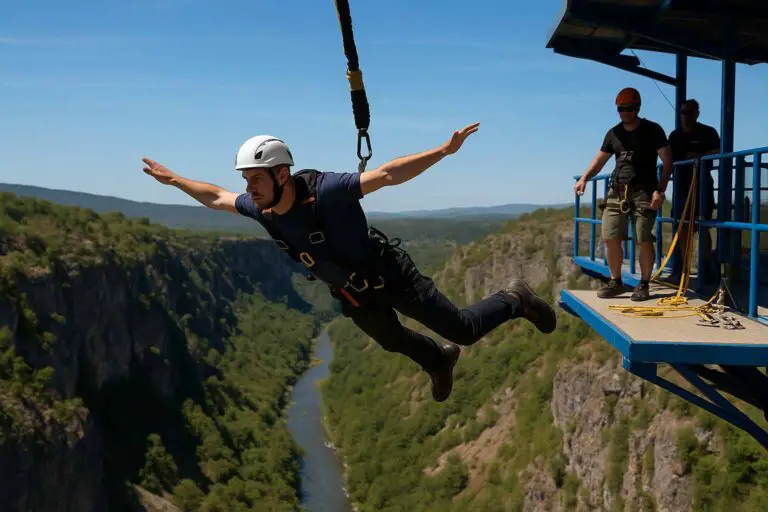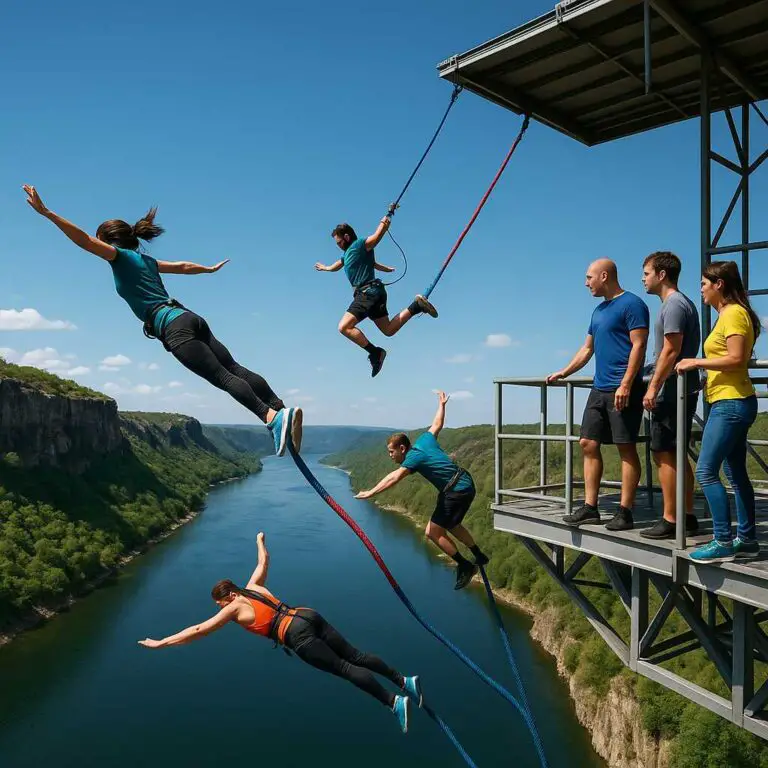Bungee jumping is a thrilling and adrenaline-pumping adventure activity that has captured the hearts of adventure seekers worldwide. The idea of free-falling from a great height, only to be snapped back by a bungee cord, is undeniably exhilarating. However, it’s important to ensure that this extreme sport is both safe and accessible for individuals of varying ages.
In this comprehensive article, we’ll explore the age limits and considerations for bungee jumping, safety measures, the overall experience, and additional fascinating facts.
The Minimum Age for Bungee Jumping
Bungee jumping isn’t just for adults; younger individuals can also partake in this thrilling activity. However, there is a minimum age requirement in place to ensure the safety of participants. The minimum age for bungee jumping varies from one location to another and is determined by several factors, including the specific bungee jumping operator and local regulations.
In the United States, for instance, the minimum age for bungee jumping is typically 18 years old. This age requirement is in place to ensure that participants are physically and mentally prepared for the experience and can adhere to safety guidelines.
But you might be interested in learning about the variations in bungee jumping age limits and regulations for other countries, and I will provide that information next.
Global Variations in Bungee Jumping Age Limits and Regulations
| Country/Region | Minimum Age for Bungee Jumping | Regulatory Body | Notes |
|---|---|---|---|
| United States | Typically 18 years old | Varies by state regulations | Age limits and regulations may differ by state; always check with the specific operator for details. |
| United Kingdom | 16 years old | Health and Safety Executive (HSE) | Participants under 18 may require parental consent; operators must adhere to HSE safety guidelines. |
| New Zealand | 10-13 years old (with conditions) | WorkSafe New Zealand | Younger participants may jump with parental consent and if they meet certain criteria set by WorkSafe. |
| Australia | Varies by state | State-level authorities | Regulations differ by state; operators must comply with local guidelines and safety standards. |
| Canada | Typically 18 years old | Provincial regulations | Age limits may vary by province; operators must follow provincial safety regulations. |
| Switzerland | Typically 16 years old | Swiss Parachute Association | Switzerland has stringent safety standards; operators must meet Swiss Parachute Association criteria. |
| South Africa | Typically 14-16 years old | South African Civil Aviation Authority | Age limits can vary; operators must adhere to aviation authority regulations. |
| China | Typically 18 years old | General Administration of Sport of China | Age limits and regulations may vary by region within China. |
| Japan | Typically 18 years old | Japan Bungee Association | Operators must follow guidelines set by the Japan Bungee Association; age limits may vary by location. |
| Brazil | Typically 16 years old | National Civil Aviation Agency | Regulations can differ by state; operators must meet the aviation agency’s safety requirements. |
Please note that the information provided is subject to change and may vary depending on specific locations and regulations. Always verify age limits and regulations with the bungee jumping operator in your chosen destination before planning your jump.
Factors Influencing Age Requirements
The age limit for bungee jumping can vary based on several factors:
1. Location and Operator
Different bungee jumping operators may have varying age requirements. Some may allow participants as young as 16, while others may set the minimum age at 21. It’s essential to check with the specific bungee jumping facility you plan to visit for their age restrictions.
2. Legal Regulations
Local and national regulations play a significant role in determining the minimum age for bungee jumping. These regulations are put in place to ensure safety standards are met. Operators must adhere to these regulations to operate legally.
3. Weight and Health Requirements
Apart from age, bungee jumping facilities often have weight and health restrictions. Participants should meet certain physical criteria to ensure their safety during the jump. These criteria may include weight limits and restrictions for individuals with specific medical conditions.
Safety Measures in Bungee Jumping
Safety is paramount in any adventure activity, and bungee jumping is no exception. Bungee jumping operators take extensive precautions to minimize risks and ensure participants’ safety. Here are some key safety measures to consider:
1. Equipment Inspection
Bungee jumping equipment undergoes rigorous inspection and maintenance to ensure its reliability. Cords, harnesses, and other gear are regularly checked and replaced if necessary.
2. Trained Staff
Experienced and certified staff are essential for a safe bungee jumping experience. They ensure that participants are properly harnessed, and they follow all safety procedures.
3. Health Assessments
Before taking the plunge, participants may be required to fill out health questionnaires. Some health conditions may disqualify individuals from bungee jumping to avoid potential risks.
4. Weight Limits
Weight limits are enforced to ensure that the bungee cord can safely support the jumper’s weight. Exceeding these limits can compromise safety.
5. Site Selection
Operators choose jump sites carefully, considering factors like water depth and surrounding terrain. This selection process minimizes potential hazards.
The Bungee Jumping Experience
Now that we’ve covered age limits and safety, let’s delve into the bungee jumping experience itself. What can you expect when you take the leap? Here’s a step-by-step breakdown:
1. Safety Briefing
Before the jump, participants receive a thorough safety briefing. This includes instructions on body positioning, how to land safely, and what to do if something goes wrong.
2. Gear Up
Participants are then outfitted with the necessary gear, including a harness and ankle attachments. The equipment is double-checked for safety.
3. The Jump
With the gear securely in place, it’s time to step to the edge. The initial moments of the jump are an adrenaline rush like no other, as you free-fall towards the ground.
4. The Rebound
Just when it feels like you’re in free fall forever, the bungee cord reaches its limit and starts pulling you back up. This rebound is a mix of exhilaration and relief.
5. Landing and Unhooking
As you reach the peak of the rebound, you’ll start descending again. Trained staff will assist in a safe landing, unhooking you from the bungee cord.
6. The Aftermath
After the jump, participants often feel a surge of adrenaline and a sense of accomplishment. It’s a unique experience that many describe as life-changing.
Tips for a Safe and Enjoyable Bungee Jump
Whether you’re a first-timer or a seasoned bungee jumper, here are some tips to ensure a safe and enjoyable experience:
1. Choose a Reputable Operator
Research and select a bungee jumping operator with a proven track record of safety and customer satisfaction. Read reviews and ask for recommendations.
2. Follow Instructions
Pay close attention during the safety briefing and follow all instructions given by the staff. Proper body positioning and following guidelines are crucial for a safe jump.
3. Dress Comfortably
Wear comfortable clothing and appropriate footwear for the jump. Avoid loose items that could get in the way.
4. Stay Hydrated and Eat Light
Stay hydrated before the jump, but avoid heavy meals. You want to feel comfortable and not too full.
5. Mentally Prepare
Bungee jumping can be mentally challenging. Take a moment to calm your nerves and focus on the excitement rather than fear.
Additional Fascinating Facts
1. Safety Records
Bungee jumping has an impressive safety record. According to the American Journal of Sports Medicine, it has a relatively low injury rate, with less than one injury per 500,000 jumps. This statistic underscores the commitment of operators to ensure participants’ safety.
In the United States, The United States Parachute Association (USPA) sets safety standards and guidelines for bungee jumping operators, contributing to its safety record.
2. Equipment Details
Bungee cords, typically made of multiple layers of latex rubber, are designed to stretch and absorb energy during the jump. Harnesses used in bungee jumping are constructed from high-strength materials such as nylon and are designed to distribute the force evenly across the body.
3. Historical Origins:
Modern bungee jumping was popularized by A.J. Hackett and Henry van Asch in New Zealand in the 1980s. They established the world’s first commercial bungee jumping operation at the Kawarau Bridge in Queenstown. However, the roots of bungee jumping can be traced back to the “land diving” ritual practiced by the indigenous people of Vanuatu in the South Pacific.
4. Bungee Jumping Locations
- The Macau Tower in China boasts one of the highest commercial bungee jumps in the world, with a platform situated at 233 meters (764 feet) above the ground.
- The Royal Gorge Bridge in Colorado, USA, offers a stunning bungee jumping experience with a suspension bridge spanning 291 meters (955 feet) over the Arkansas River.
5. International Regulations
The European Standard EN 15567 sets safety and operational requirements for bungee jumping in Europe. In Australia, bungee jumping operators must comply with state-specific regulations, such as those imposed by WorkSafe Victoria.
Frequently Asked Questions (FAQs)
1. Is bungee jumping safe?
Bungee jumping can be safe when conducted by reputable operators who adhere to strict safety guidelines and regulations. It’s essential to choose a well-established bungee jumping facility with a good safety track record.
2. Can I go bungee jumping if I have a fear of heights?
While bungee jumping involves a significant height, some individuals with a fear of heights have successfully overcome their fears by taking the plunge. However, it’s essential to consult with a mental health professional and inform the bungee jumping staff about your fear before attempting a jump.
3. What should I wear for a bungee jump?
Wear comfortable clothing suitable for the weather conditions. Avoid loose items such as scarves or jewelry that could interfere with the jump. Most facilities provide necessary safety gear, including a harness.
4. Can I go bungee jumping if I have a medical condition?
Bungee jumping operators typically require participants to fill out health questionnaires. Some medical conditions may disqualify individuals from jumping due to safety concerns. It’s crucial to be honest about your medical history to ensure your safety.
5. Are there weight restrictions for bungee jumping?
Yes, most bungee jumping facilities have weight limits to ensure the bungee cord can safely support the jumper’s weight. Exceeding these limits can pose safety risks.
6. Is there an age limit for spectators at bungee jumping sites?
Age limits for spectators can vary by location and operator. Some facilities may have age restrictions for spectators due to safety or liability concerns. Check with the specific facility for their policy on spectators.
7. Can I bring my own camera or GoPro for recording the jump?
Many bungee jumping facilities have restrictions on bringing personal cameras or recording equipment during the jump for safety reasons. Some offer video and photo packages that you can purchase to capture your experience.
8. How long does a typical bungee jump last?
The duration of a bungee jump varies depending on factors such as the jump height and rebound of the bungee cord. Generally, the entire experience, including the fall and rebound, lasts only a few minutes.
9. Can I bungee jump if I’m pregnant?
Bungee jumping is not recommended for pregnant individuals due to potential risks. It’s advisable to consult with a healthcare professional for guidance on adventure activities during pregnancy.
10. Are there age limits for tandem bungee jumping (jumping with a partner)?
Age limits for tandem bungee jumping may differ from solo jumps. Some facilities may allow younger participants to jump with parental consent, while others may have stricter age requirements.
Always consult with the specific bungee jumping operator for detailed information and to address any specific concerns or questions you may have about your bungee jumping experience.
Conclusion
Bungee jumping is an adventure activity that transcends age, offering a unique thrill that’s hard to find elsewhere. While there are age limits in place to ensure safety, individuals of various ages can participate, provided they meet the criteria set by bungee jumping operators and local regulations.
Remember, safety is paramount in bungee jumping. Operators take extensive precautions, from equipment inspections to trained staff and health assessments, to ensure a secure experience. Following safety guidelines and choosing a reputable operator will enhance your enjoyment of this exhilarating adventure.
So, if you’ve ever dreamt of taking that daring leap off a towering bridge or platform, rest assured that with the right preparations and a trusted operator, bungee jumping can be an unforgettable experience, regardless of your age.
You might also like to read this article next: Exploring The Age Limits For Ziplining








